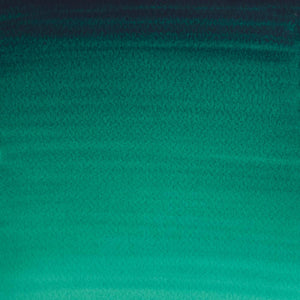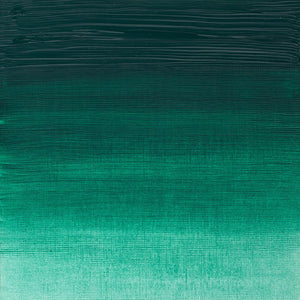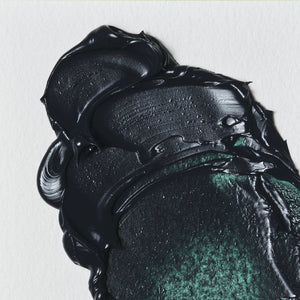
A history of viridian
Hydrated chromium oxide is an intense green pigment with a bluish hue, more commonly known in the English-speaking world as viridian. Viridian comes from the Latin viridis meaning “green, blooming, vigorous”. This may seem at odds with its unnatural appearance but when mixed with yellow, orange, or red it gives life to an impressive range of natural greens. This makes viridian a versatile staple for many artists to this day.
Viridian emerged in the first half of the nineteenth century, along with many other synthetic pigments, such as cobalt blue and cadmium yellow. While chromium, the key component, was discovered in 1797, the first preparation of viridian is credited to the Frenchman Pannetier and his assistant Binet in around 1838.
Unfortunately, Pannetier’s green was over a hundred times more expensive than other already pricey pigments on the market. Twenty years later Guignet patented a cheaper method for manufacture, which greatly increased its popularity. Once viridian, also known as Guignet’s green, became more affordable, it was a popular choice for the Impressionists and Post-Impressionists.
Viridian as a pigment
Viridian was an attractive choice for artists at that time because there had previously been limited options for green pigments. Emerald green (copper acetoarsenite, and not to be confused with verte emeraude, the French name for viridian), was one of the most vibrant alternatives. However, its arsenic content made it very dangerous and, in some cases, deadly. Chromium oxide green was much less toxic but its dark and dull colour made it a less appealing choice.
In contrast, viridian green was both non-toxic due to its insolubility and had an intense colour. Moreover, viridian has excellent lightfastness and as a transparent pigment it is very suitable for the glazing technique. The high oil absorption of viridian makes it a fast-drying oil paint. Artists such as Georgia O’Keeffe, who made meticulous studies of the properties of paints, used substances like walnut oil to slow the drying rate of viridian on her palette.
Recently viridian has been playing an important role in the authentication of masterpieces. Analyses of artworks by Van Gogh, Kandisky and Klee have revealed that viridian produced around the turn of twentieth century contains a by-product not found in modern manufacture of the pigment. Examination of viridian has therefore been added to the battery of tests used to date and authenticate works.
Viridian the brand
In 1991 the BBC brought in the international brand specialists Lambie-Nairn to rejuvenate the look of BBC Two. At the time the channel was considered by audiences to be “worthy but dull”. Lambie-Nairn then produced the series of iconic moving logos featuring the number two in a range of materials, from water and paint to silk and grass, all in copyrighted BBC Two viridian. Viridian remained the signature colour of BBC Two until 2001.
The BBC is not the only organisation to harness the impact of viridian. In 1998 Bruce Sterling founded the Viridian Design Movement, an avant-garde art movement focused on addressing climate change. In its manifesto, Sterling stated: “The world needs a new, unnatural, seductive, mediated, glamorous Green. A Viridian Green, if you will.”
Important artworks featuring viridian
- Georgia O’Keeffe ‘Pool in the Woods, Lake George’ (1922)
- Édouard Manet ‘The Balcony’ (1868-69)
- Claude Monet ‘Arrival of the Normandy Train, Gare Saint-Lazare’ (1877)




![WN PWC KAREN KLUGLEIN BOTANICAL SET [OPEN 3]](http://www.winsornewton.com/cdn/shop/files/136448.jpg?crop=center&v=1761625362&width=20)
![WN PWC KAREN KLUGLEIN BOTANICAL SET [FRONT]](http://www.winsornewton.com/cdn/shop/files/136444.jpg?crop=center&v=1761625362&width=20)
![WN PWC ESSENTIAL SET [CONTENTS 2]](http://www.winsornewton.com/cdn/shop/files/137579.jpg?crop=center&v=1761625558&width=20)
![WN PWC ESSENTIAL SET [FRONT]](http://www.winsornewton.com/cdn/shop/files/137583.jpg?crop=center&v=1761625558&width=20)
![W&N GALERIA CARDBOARD SET 10X12ML 884955097809 [OPEN]](http://www.winsornewton.com/cdn/shop/files/138856.jpg?crop=center&v=1761626083&width=20)
![W&N GALERIA CARDBOARD SET 10X12ML [B014096] 884955097809 [FOP]](http://www.winsornewton.com/cdn/shop/files/138855.jpg?crop=center&v=1761626083&width=20)
![W&N PROMARKER 24PC STUDENT DESIGNER 884955043295 [OPEN]](http://www.winsornewton.com/cdn/shop/files/78675_d6356b09-bd48-4280-8df1-eefc85a4de3b.jpg?crop=center&v=1761841229&width=20)
![W&N PROMARKER 24PC STUDENT DESIGNER 884955043295 [FRONT]](http://www.winsornewton.com/cdn/shop/files/78674_d4d78a69-7150-4bf4-a504-3cb5304b0f80.jpg?crop=center&v=1721326116&width=20)

![W&N PROFESSIONAL WATER COLOUR TYRIAN PURPLE [SWATCH]](http://www.winsornewton.com/cdn/shop/files/136113.jpg?crop=center&v=1724423390&width=20)
![W&N WINTON OIL COLOUR [COMPOSITE] 37ML TITANIUM WHITE 094376711653](http://www.winsornewton.com/cdn/shop/files/9238_5073745e-fcfe-4fad-aab4-d631b84e4491.jpg?crop=center&v=1721326117&width=20)
![W&N WINTON OIL COLOUR [SPLODGE] TITANIUM WHITE](http://www.winsornewton.com/cdn/shop/files/131754_19b392ee-9bf6-4caf-a2eb-0356ec1c660a.jpg?crop=center&v=1721326118&width=20)